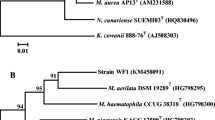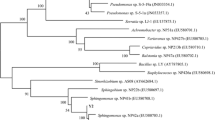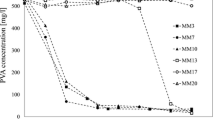Abstract
The present study describes the phenanthrene-degrading activity of Sphingomonas paucimobilis 20006FA and its ability to promote the bioavailability of phenanthrene. S. paucimobilis 20006FA was isolated from a phenanthrene-contaminated soil microcosm. The strain was able to grow in liquid mineral medium saturated with phenanthrene as the sole carbon source, showing high phenanthrene elimination (52.9% of the supplied phenanthrene within 20 days). The accumulation of 1-hydroxy-2-naphthoic acid and salicylic acid as major phenanthrene metabolites and the capacity of the strain to grow with sodium salicylate as the sole source of carbon and energy indicated that the S. paucimobilis 20006FA possesses a complete phenanthrene degradation pathway. However, under the studied conditions, the strain was able to mineralize only the 10% of the consumed phenanthrene. Investigations on the cell ability to promote bioavailability of phenanthrene showed that the S. paucimobilis strain 20006FA exhibited low cell hydrophobicity (0.13), a pronounced chemotaxis toward phenanthrene, and it was able to reduce the surface tension of mineral liquid medium supplemented with phenanthrene as sole carbon source. Scanning electron micrographs revealed that: (1) in suspension cultures, cells formed flocks and showed small vesicles on the cell surface and (2) cells were also able to adhere to phenanthrene crystals and to produce biofilms. Clearly, the strain seems to exhibit two different mechanisms to enhance phenanthrene bioavailability: biosurfactant production and adhesion to the phenanthrene crystals.







Similar content being viewed by others
References
Baboshin M, Akimov V, Baskunov B, Born TL, Khan SU, Golovlela L (2008) Conversion of polycyclic aromatic hydrocarbons by Sphingomonas sp. VKM B-2434. Biodegradation 19:567–576
Balkwill DL, Drake GR, Reeves RH, Frederikson JK, White DC (1997) Taxonomic study of aromatic-degrading bacteria from deep-terrestrial-subsurface sediments and description of Sphingomonas aromaticivorans sp. nov., Sphingomonas subterranea sp. nov., and Sphingomonas stygia sp. nov. Int J Syst Bacteriol 47:191–201
Bastiaens L, Springael D, Wattiau P, Harms H, DeWachter R, Verachtert H, Diels L (2000) Isolation of adherent polycyclic aromatic hydrocarbon (PAH)-degrading bacteria using PAH-sorbing carriers. Appl Environ Microbiol 66:1834–1843
Berthe-Corti L, Bruns A, Hulsch R (1997) Semi-continuous-flow cultures with marine sediment suspensions containing non-polar carbon sources—culture control by a pneumatic sediment suspension dosage system. J Microbiol Methods 29:129–137
Coppotelli BM, Ibarrolaza A, Del Panno MT, Morelli IS (2008) Effects of the inoculant strain Sphingomonas paucimobilis 20006FA on soil bacterial community biodegradation in phenanthrene-contaminated soil. Microb Ecol 55:173–183
Cunliffe M, Kertesz MA (2006) Effect of Sphingobium yanoikuyae B1 inoculation on bacterial community dynamics and polycyclic aromatic hydrocarbon degradation in aged and freshly PAH-contaminated soils. Environ Pollut 144:228–237
Cunliffe M, Kertesz MA (2006) Autecological properties of soil sphingomonads involved in the degradation of polycyclic aromatic hydrocarbons. Appl Environ Biotechnol 72:1083–1089
Fernandez-Linares LM, Acquiviva M, Bertrand JC, Gauthier M (1996) Effect of sodium chloride concentration on growth and degradation of eicosane by the marine halotolerant bacterium Marinobacter hydrocarbonoclasticus. Syst App Microbiol 19:113–121
Fialho AM, Moreira LM, Granja AT, Popescu AO, Hoffmann K, Sá-Correira I (2008) Occurrence, production, and applications of gellan: current state and perspectives. Appl Microbiol Biotechnol 79:889–900
Gilewicz M, Nadalig NT, Budzinski H, Doumenq P, Michotey V, Bertrand JC (1997) Isolation and characterization of a marine bacterium capable of utilizing 2-methylphenanthrene. Appl Microbiol Biotechnol 48:528–533
Harms H, Bosma TNP (1997) Mass transfer limitation of microbial growth and pollutant degradation. J Ind Microbiol Biotech 18:97–105
Johnsen AR, Karlson U (2004) Evaluation of bacterial strategies to promote the bioavailability of polycyclic aromatic hydrocarbons. Appl Microbiol Biotechnol 63:452–459
Johnsen AR, Wick LY, Harms H (2005) Principles of microbial PAH-degradation in soil. Environ Pollut 133:71–84
Kästner M, Maroh B, Weinberg (1993) Biologische Schadstoffe in Böden. Economia, Bonn
Kazunga C, Aitken MD (2000) Products of incomplete metabolism of pyrene by polycyclic aromatic hydrocarbon-degrading bacteria. Appl Environ Microbiol 66:1917–1922
Lanfranconi MP, Alvarez HM, Studdert CA (2003) A strain isolated from gas oil-contaminated soil displays chemotaxis towards gas oil and hexadecane. Environ Microbiol 5:1002–1008
Leys NM, Ryngaert A, Bastiaens L, Top EM, Verstraete W, Springael D (2005) Culture independent detection of Sphingomonas sp. EPA 505 related strains in soils contaminated with polycyclic aromatic hydrocarbons (PAHs). Microb Ecol 49:443–450
Maneerat S (2005) Biosurfactants from marine microorganisms. Songklanakarin J Sci Technol 27:1263–1272
Mueller JG, Chapman PJ, Blattmann BO, Pritchard PH (1990) Isolation and characterization of a fluoranthene-utilizing strain of Pseudomonas paucimobilis. Appl Environ Microbiol 56:1079–1086
Neu TR (1996) Significance of bacterial surface-active compounds in interaction of bacteria with interfaces. Microbiol Rev 60:151–166
Pinyakong O, Habe H, Supaka N, Pinpanichkarn P, Juntongjin K, Yoshida T, Furihata K, Nojiri H, Yamane H, Omori T (2000) Identification of novel metabolites in the degradation of phenanthrene by Sphingomonas sp. strain P2. FEMS Microbiol Lett 191:115–121
Reasoner D, Geldreich E (1985) A new medium for the enumeration and subculture of bacteria from potable water. Appl Environ Microbiol 49:1–7
Rosenberg M, Rosenberg E (1981) Role of adherence in growth of Acinetobacter calcoaceticus RAG-1 on hexadecane. J Bacteriol 148:51–57
Santos EC, Jacques RJS, Bento FM, Peralba MCR, Selbach PA, Sá ELS, Camargo FAO (2008) Anthracene biodegradation and surface activity by an iron-stimulated Pseudomonas sp. Bioresource Technol 99:2644–2649
Semple KT, Doick KJ, Lukas YW, Harms H (2007) Microbial interactions with organic contaminants in soil: Definitions, processes and measurement. Environ Pollut 150:166–176
Story SP, Parker SH, Hayasaka SS, Riley MB, Kline EL (2001) Convergent and divergent points in catabolic pathways involved in utilization of fluoranthene, naphthalene, anthracene, and phenanthrene by Sphingomonas paucimobilis var. EPA505. J Ind Microbiol Biotechnol 26:369–382
Tamura K, Dudley J, Nei M, Kumar S (2007) MEGA4: Molecular Evolutionary Genetics Analysis (MEGA) software version 4.0. Mol Biol Evol 24:1596–1599
Tao XQ, Lee GN, Dang Z, Yang C, Yi XY (2007) A phenanthrene degrading strain Sphingomonas sp. GY2B isolated from contaminated soils. Process Biochem 42:401–408
van Veen JA, van Oberbeek LS, van Elsas JD (1997) Fate and activity of microorganisms introduced into soil. Microbiol Mol Biol Rev 61:121–135
Vecchioli GI, Del Panno MT, Panceira MT (1990) Use of selected autochthonous soil bacteria to enhance degradation of hydrocarbons in soil. Environ Pollut 67:249–258
Wick LY, de Munain AR, Springael D, Harms H (2002) Responses of Mycobacterium sp. LB501 to the low bioavailability of solid anthracene. Appl Microbiol Biotechnol 58:378–385
Willumsen PA, Karlson U (1996) Screening of bacteria, isolated from PAH-contaminated soils, for production of biosurfactants and bioemulsifiers. Biodegradation 7:415–423
Xia Y, Min H, Rao G, Liu ZM, Liu J, Ye YP, Duan XJ (2005) Isolation and characterization of phenanthrene-degrading Sphingomonas paucimobilis strain ZX4. Biodegradation 16:393–402
Yakimov MM, Golyshin PN, Lang S, Moore ERB, Abraham WR, Lünsdrof H, Timmis KM (1998) Alkanivorax borkumensis gen. nov., sp. nov., a new hydrocarbon-degrading and surfactant–producing marine bacterium. Int J Syst Bacteriol 48:339–348
Zhao HP, Wang L, Ren JR, Li Z, Li M, Gao HW (2008) Isolation and characterization of phenanthrene-degrading strains Sphingomonas sp. ZP1 and Tristella sp. ZP5. J Hazard Mater 152:1293–1300
Acknowledgements
We thank Dipl. Ing. Reiner Hulsch for his help with the bioreactors and Ms. Kort and Dr. Rhiel for their help in performing SEM analysis. This work was supported by the Agencia Nacional de Promoción Científica y Tecnológica (PICT2006-884) and a DAAD scholar ship for Ms. Bibiana Coppotelli. Coppotelli B. is postdoctoral fellow of CONICET, Ibarrolaza A. is doctoral fellow of CONICET, and Dias R. is a doctoral fellow of CIC-PBA.
Author information
Authors and Affiliations
Corresponding author
Rights and permissions
About this article
Cite this article
Coppotelli, B.M., Ibarrolaza, A., Dias, R.L. et al. Study of the Degradation Activity and the Strategies to Promote the Bioavailability of Phenanthrene by Sphingomonas paucimobilis Strain 20006FA. Microb Ecol 59, 266–276 (2010). https://doi.org/10.1007/s00248-009-9563-3
Received:
Accepted:
Published:
Issue Date:
DOI: https://doi.org/10.1007/s00248-009-9563-3




